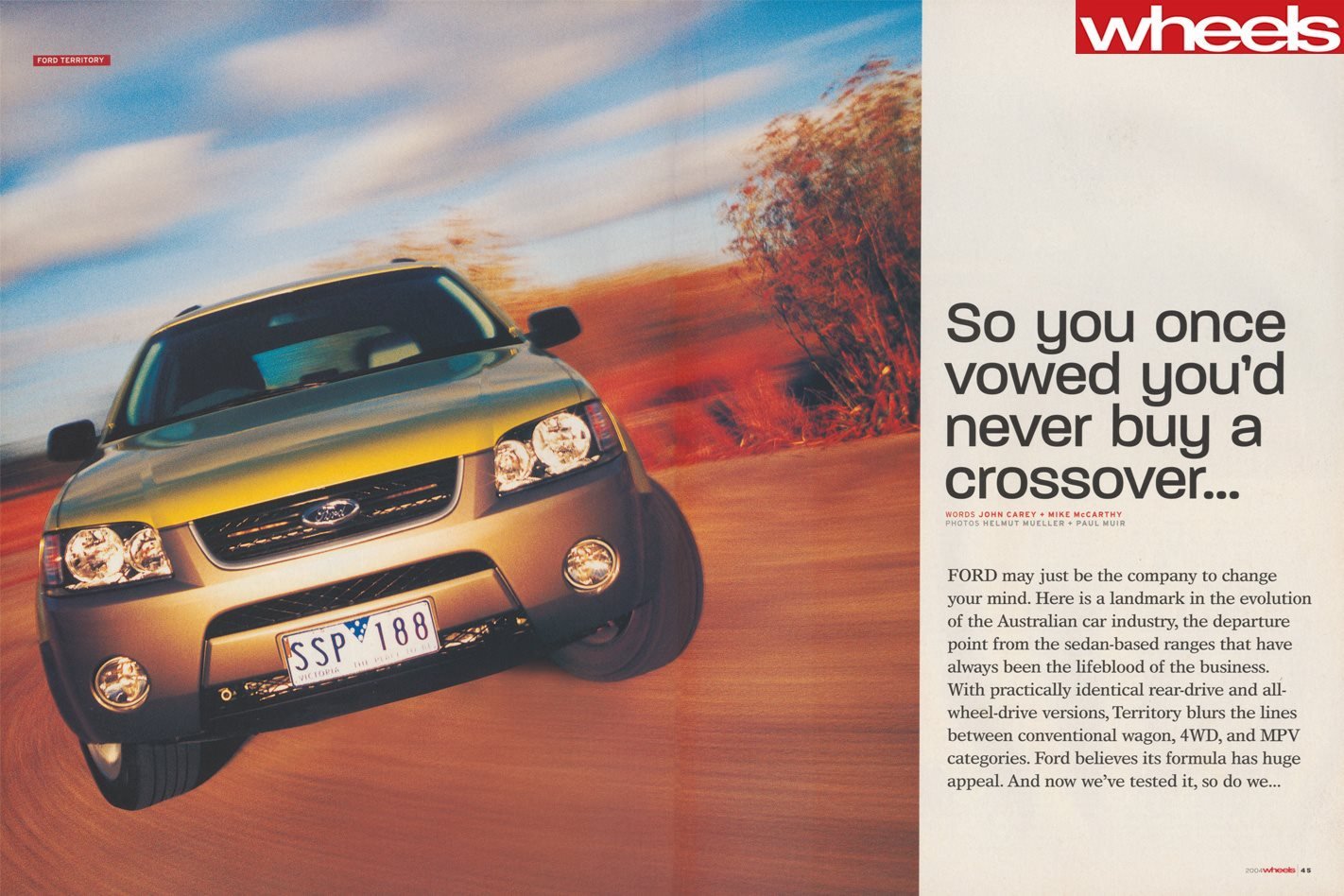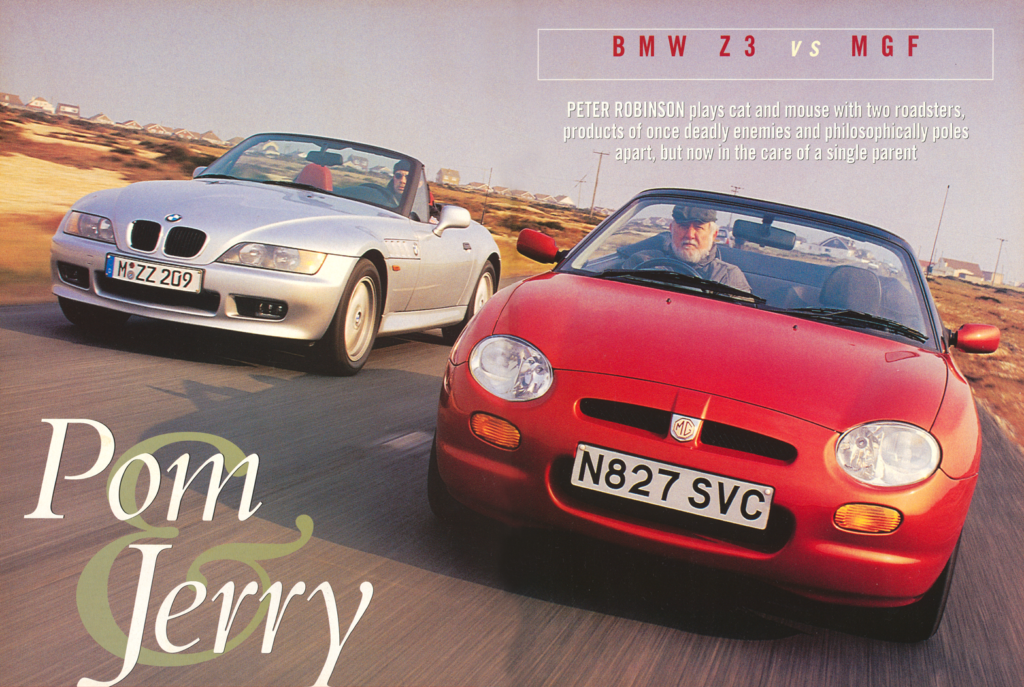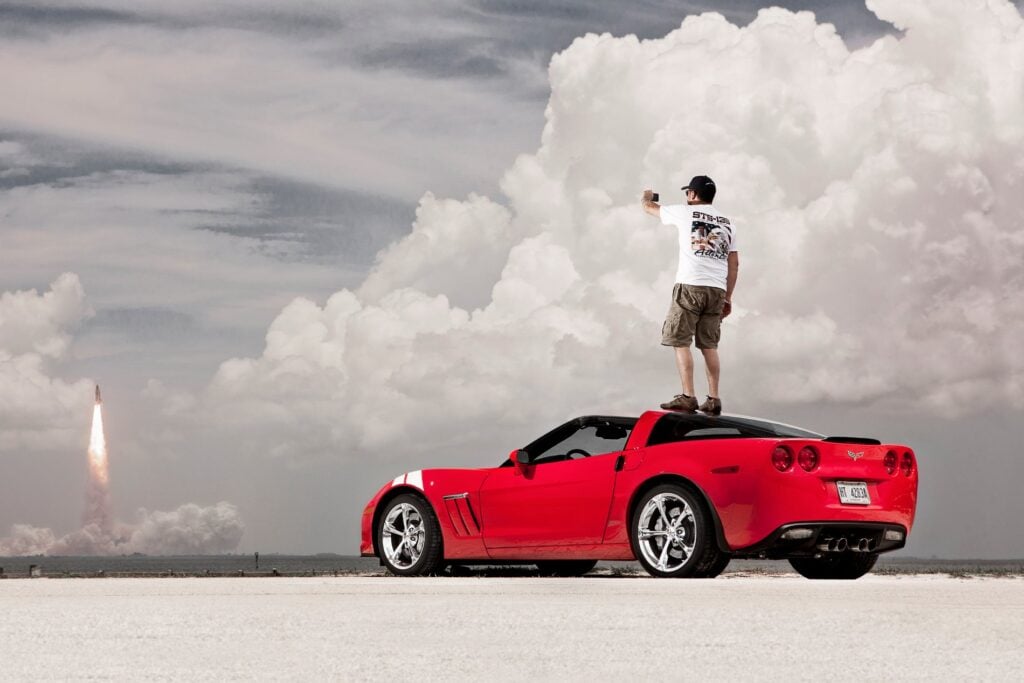So you once vowed you’d never buy a crossover…
FORD may just be the company to change your mind.
Here is a landmark in the evolution of the Australian car industry, the departure point from the sedan-based ranges that have always been the lifeblood of the business . .
With practically identical rear-drive and all-wheel-drive versions, The Ford Territory blurs the lines between conventional wagon, 4WD, and MPV categories. Ford believes its formula has huge appeal. And now we’ve tested it, so do we…
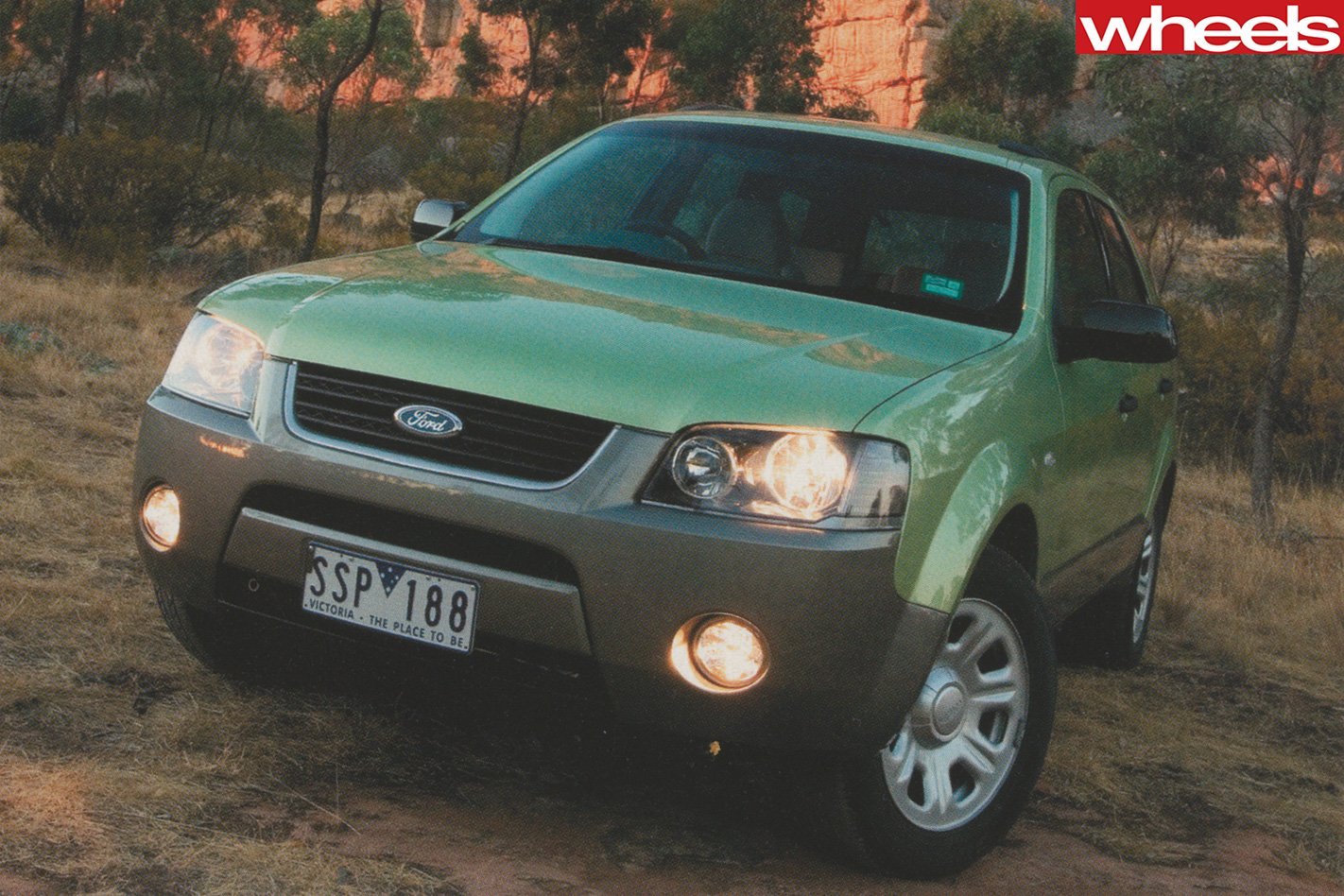
So you once vowed you’d never buy a crossover was first published in Wheels May 2004
Most people, seeing it for the first time, automatically file it in a familiar, existing category of car. It’s a good-looking and slightly lower-than-usual 4WD wagon, right? A softroader, isn’t that what they’re called?
Wrong. The Territory RWD looks exactly like the AWD model – ground clearance, and wheel and tyre size are exactly the same – except that it doesn’t have a pair of discreet chrome badges stuck beside the indicator repeater lights on its front guards.
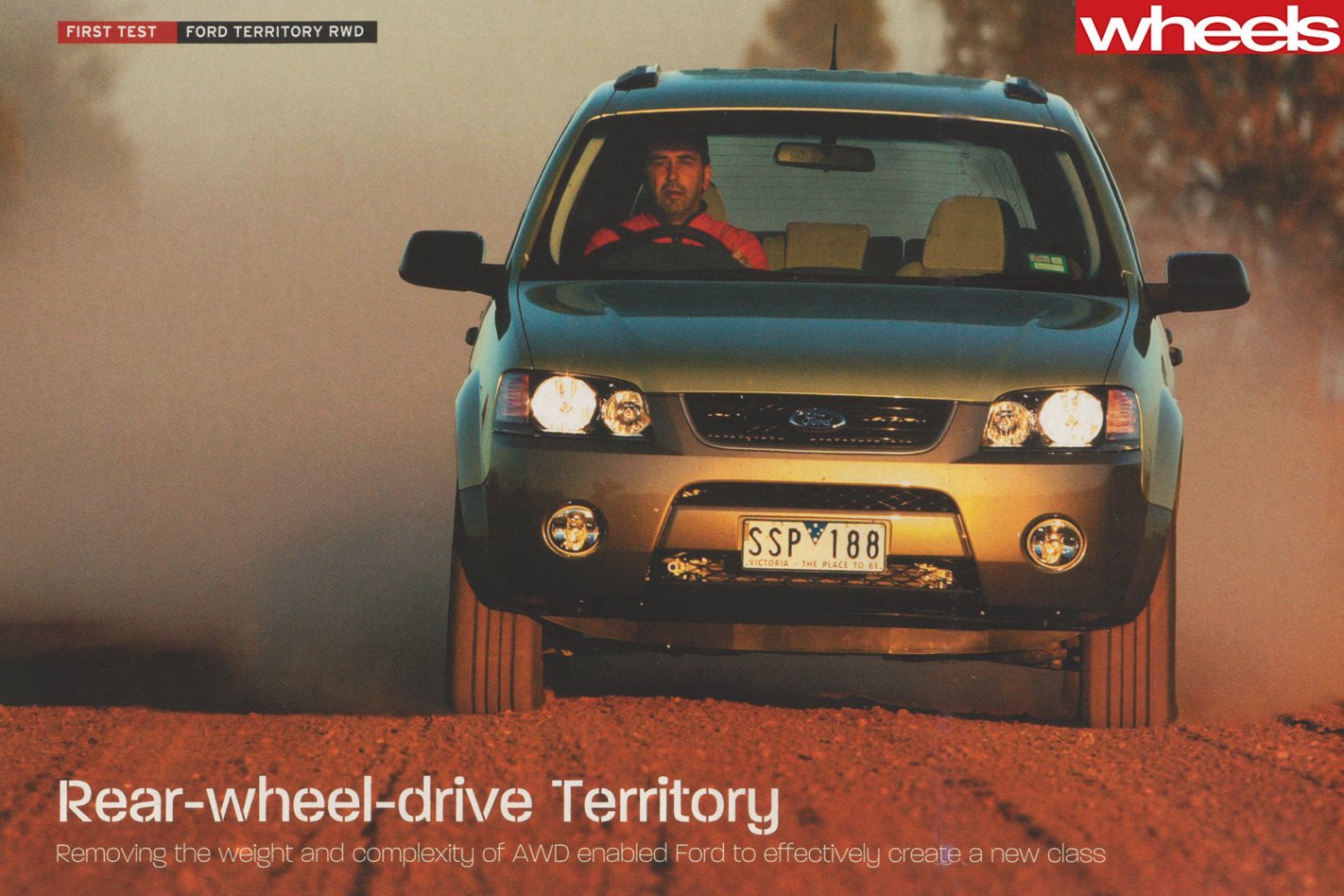
Its price – $38,990 before the addition of any options or accessories – means the Territory TX RWD costs around the same money as a top-spec Honda CR-V, Nissan X-Trail, or Toyota RAV4, all with four-cylinder engines and only five seats. The TX, like every other Territory model, is equipped with Ford’s well-developed 4.0-litre six-cylinder engine.
It’s larger, roomier, and performs better. For those who realise they don’t really need AWD or off-road ability, the rear-drive Ford must be considered an attractive alternative.
For a reasonable $1500, the customer can add the factory-fitted extra seat. This price, by the way, includes two three-point seatbelts for the rear-seat passengers and the otherwise optional fore-aft adjustment feature for both sections of the 60/40-split second-row seat.
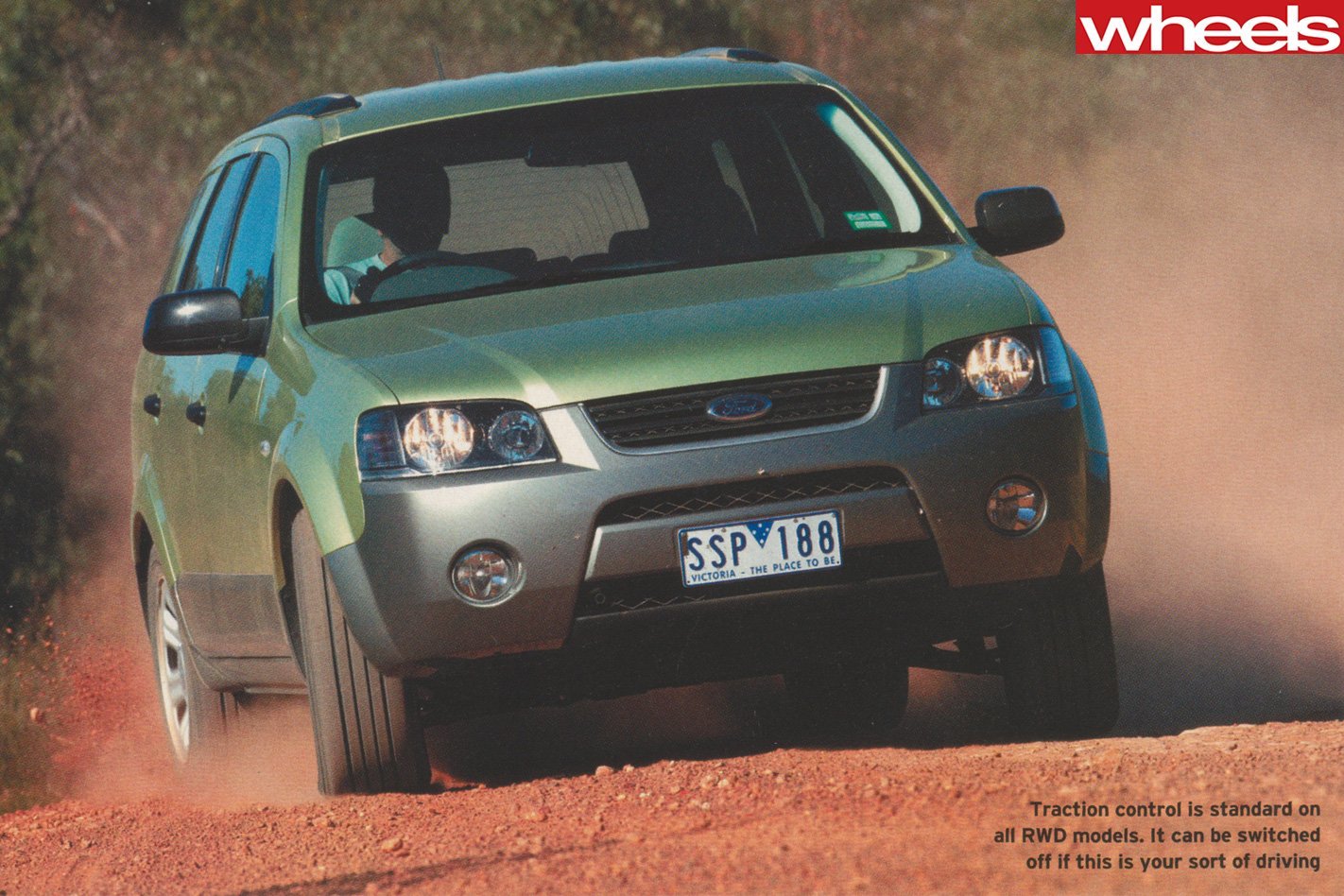
Oh, and there’s one more thing; the Territory TX is a much better car to drive than any of the above. Its steering, handling, and ride comfort are outstanding. Truly. Our wide-ranging test covered more than 100km. City lanes, freeways, suburban streets, major highways, country backroads, and a lashing of dirt for good measure. There’s no remotely comparable vehicle that approaches the TerritoryTX RWD’s dynamic ability. None.
The brand-new front suspension and front-mounted steering rack, designed and developed by Ford Australia specifically for the Territory, works brilliantly. It delivers a tight turning circle – better than some sedans we can think of (okay, the Mitsubishi Magna) –- and this helps make it very user-friendly in car parks and city lanes. The steering’s power assistance is not too light and the weighting remains admirably consistent. The Territory RWD’s steering is noticeably lighter than in the AWD, and there’s also more road feel.
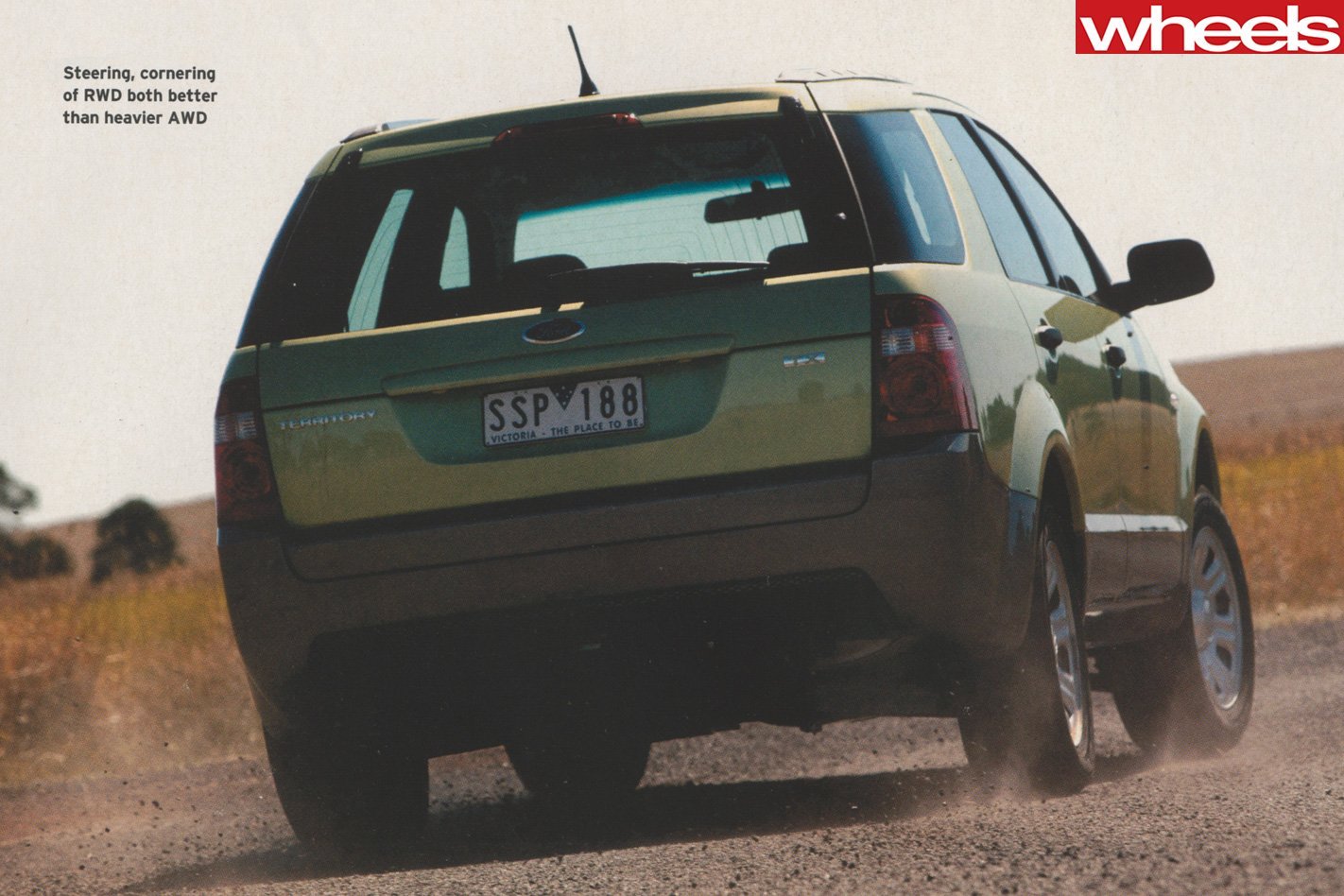
The handling is very, very good, too. There’s a wonderful balance and fluidity to the way the Territory deals with winding roads. It doesn’t lurch, or buck, or scrabble like other vehicles this large and heavy. Not only is it truly car-like, it’s like a bloody good car.
Compared with the AWD, the Territory RWD’s handling is noticeably more agile. It’s more nimble in changes of direction and prompter in its response to steering inputs. It will, when provoked, push wide in a corner. The understeer builds progressively, and the steering sends clear communication to the driver that the limit of front-end grip has been exceeded.
On dirt – or any other slippery surface, for that matter- the Territory AWD feels better. More stable both when driving in a straight line or around a bend. The rear-drive Territory is a very benign and forgiving wagon to drive on dirt, and its standard switchable traction control system is effective without being an annoying electronic nanny, but the AWD is better.
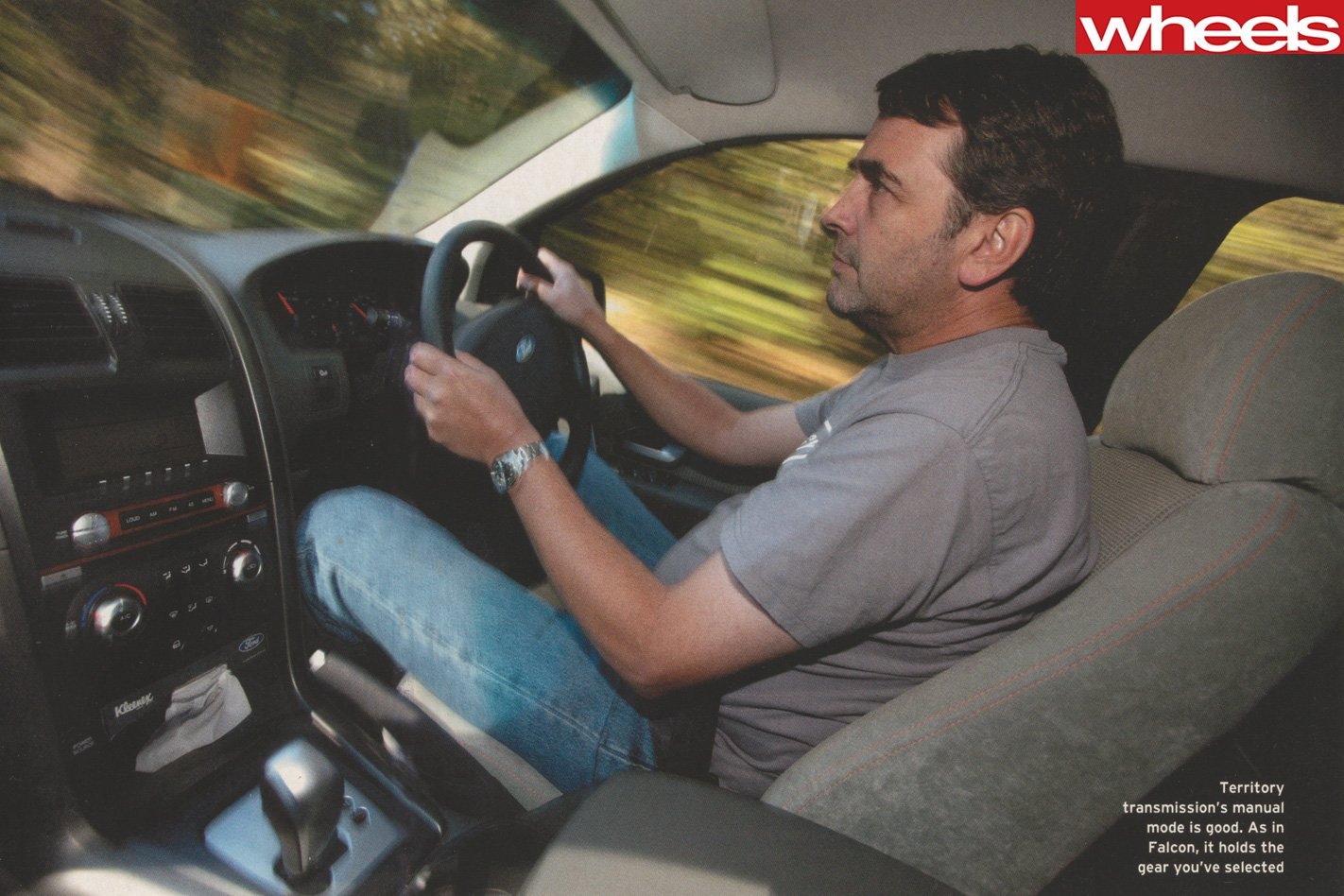
Braking? Pretty good. No sign of fade, even when repeatedly pressured during the handling section of the road test. Like the Territory AWD, the RWD is fitted with larger brakes than the lighter Falcon. All four Territory brake discs are 322mm diameter, although those at the front are 2mm thicker than the rears. At first, particularly at low speed, they give the impression that a little more initial bite would be welcome. It’s a feeling that doesn’t last long.
There’s no escaping the fact that the Territory is a heavy vehicle. The weight of the TX RWD, according to Ford, is 2005kg. Adding the optional third-row seat, as on the test vehicle, increases the figure by 32kg. This means the Territory AWD is lighter than a similarly equipped, traditional separate-chassis 4WD wagon such as the Toyota Prado, but not by as much as you might expect. The two are very close to the same length, and the slightly wider Ford’s weight advantage over the noticeably taller Toyota is around 75kg.
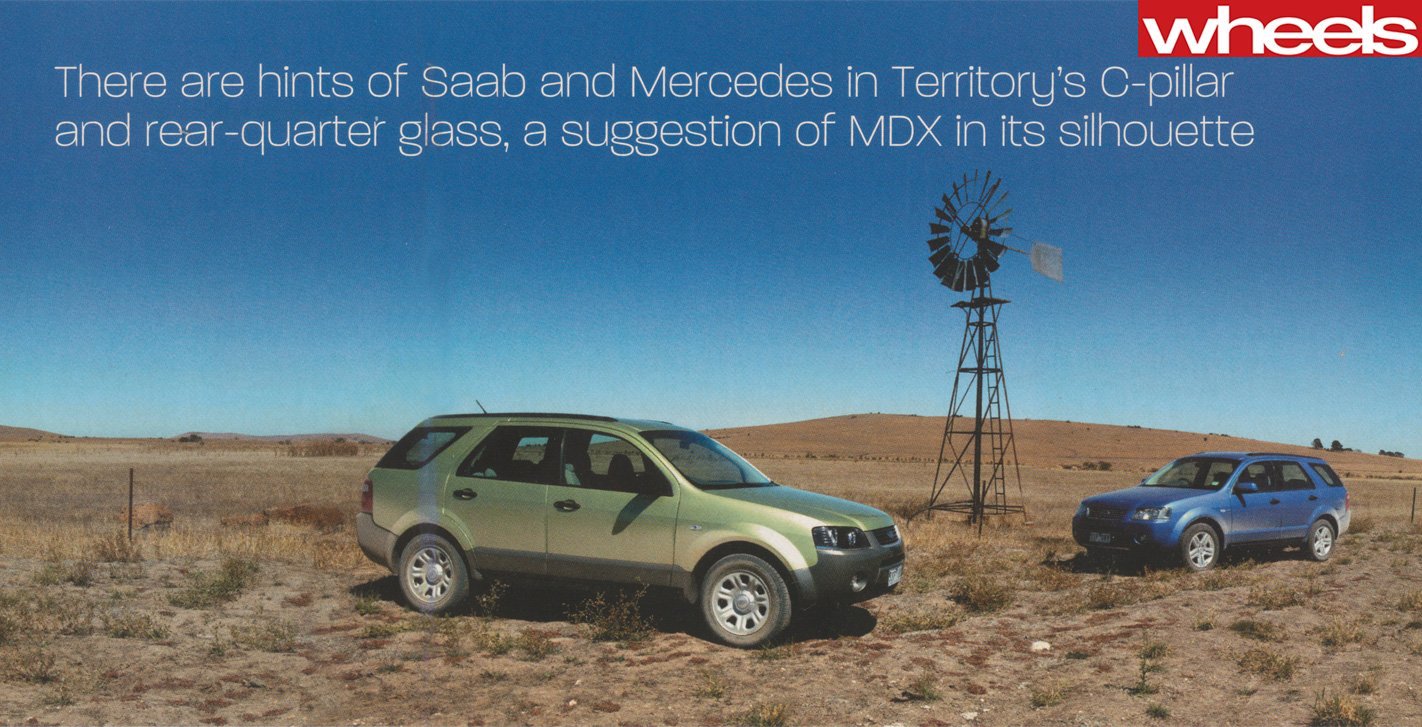
It takes about a second longer to accelerate from standstill to 100km/h.
Incidentally, with an even shorter 4.10:1 final drive, the Territory AWD’s performance is practically identical to the RWD. There are differences in fuel consumption, naturally. The official figures suggest the AWD uses three percent more than the RWD. Over the course of our test, however, the RWD averaged 13.7L/100km and the AWD consumed 11 percent more 91-octane unleaded on average.
Fuel economy may not be outstanding, but it’s tough to fault the drivetrain in any other way. An additional speed, or two, in the transmission would no doubt bring welcome incremental improvements in performance and fuel consumption. That said, the big engine is strong enough to cover the broad gaps between the four-speeder’s gears quite well. What’s most striking about the drivetrain is its high-level refinement. It might be the same engine as in Falcon, but installed in a Territory the six is perceptibly quieter and seems smoother.
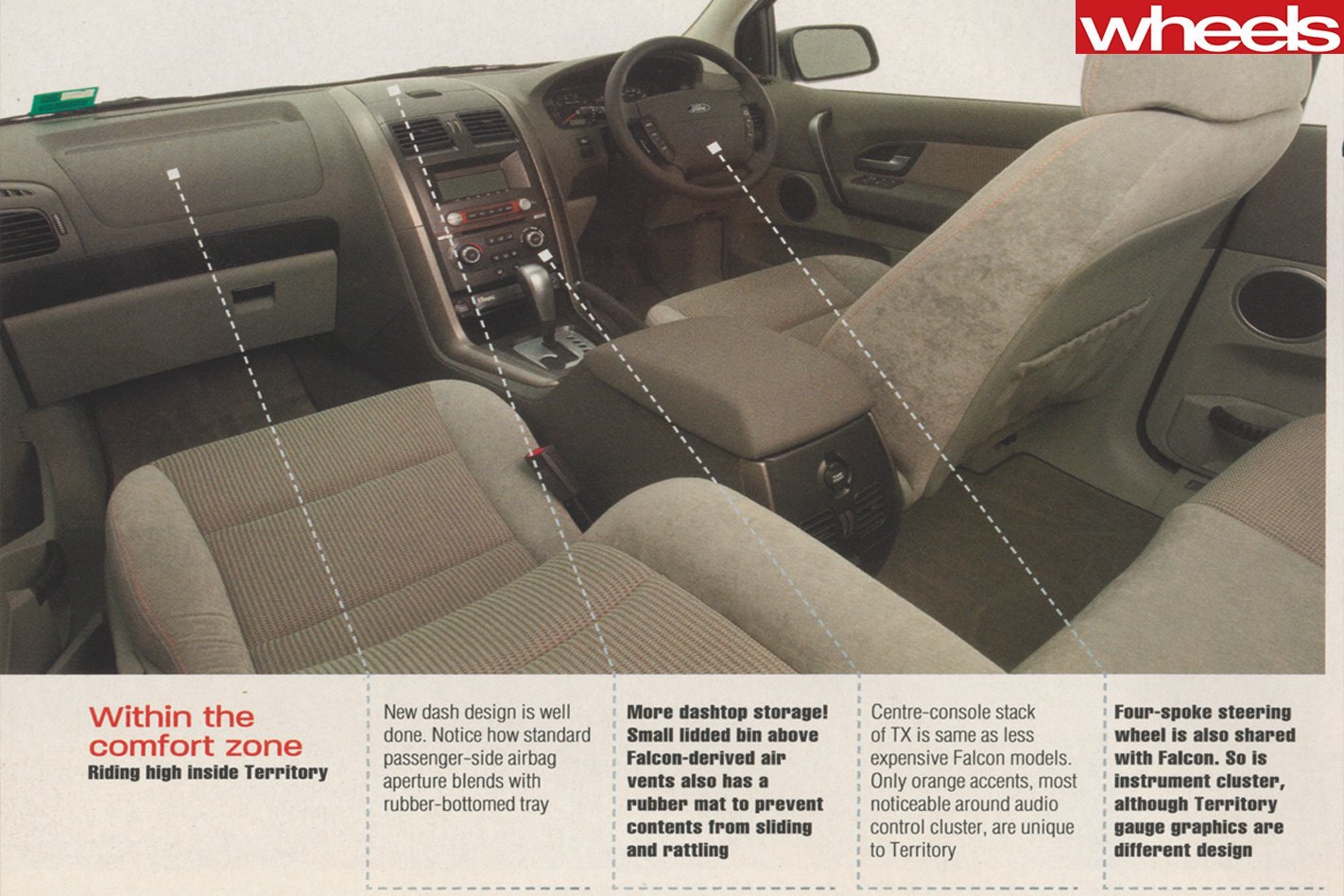
The ambience will be familiar to anyone who’s seen a recent Falcon. The instrument cluster, steering wheel, heating, ventilation and air-conditioning controls, and face-level vents are all borrowed from the BA Falcon, but the Territory’s dash is a new part.
Territory is wider inside and out than the Ford sedan, although 60mm shorter in length. The additional width isn’t so apparent from the very comfortable front seats, but it makes the car’s second-row seat remarkably roomy. There’s noticeably more shoulder room than in a Falcon, and vastly better headroom and legroom. This, too, is a comfortable seat, with well-angled cushion and backrest. There are three-point seatbelts for all three seating positions (the centre belt’s reel is inside the backrest).
The second-row seat is split 60/40. Each section can be folded down individually. As in the Mazda 6 hatchback and wagon, the folding mechanism is cleverly designed to lower the cushion as the backrest flops down. This refinement means the cargo-bay floor is perfectly flat when the seat is folded.
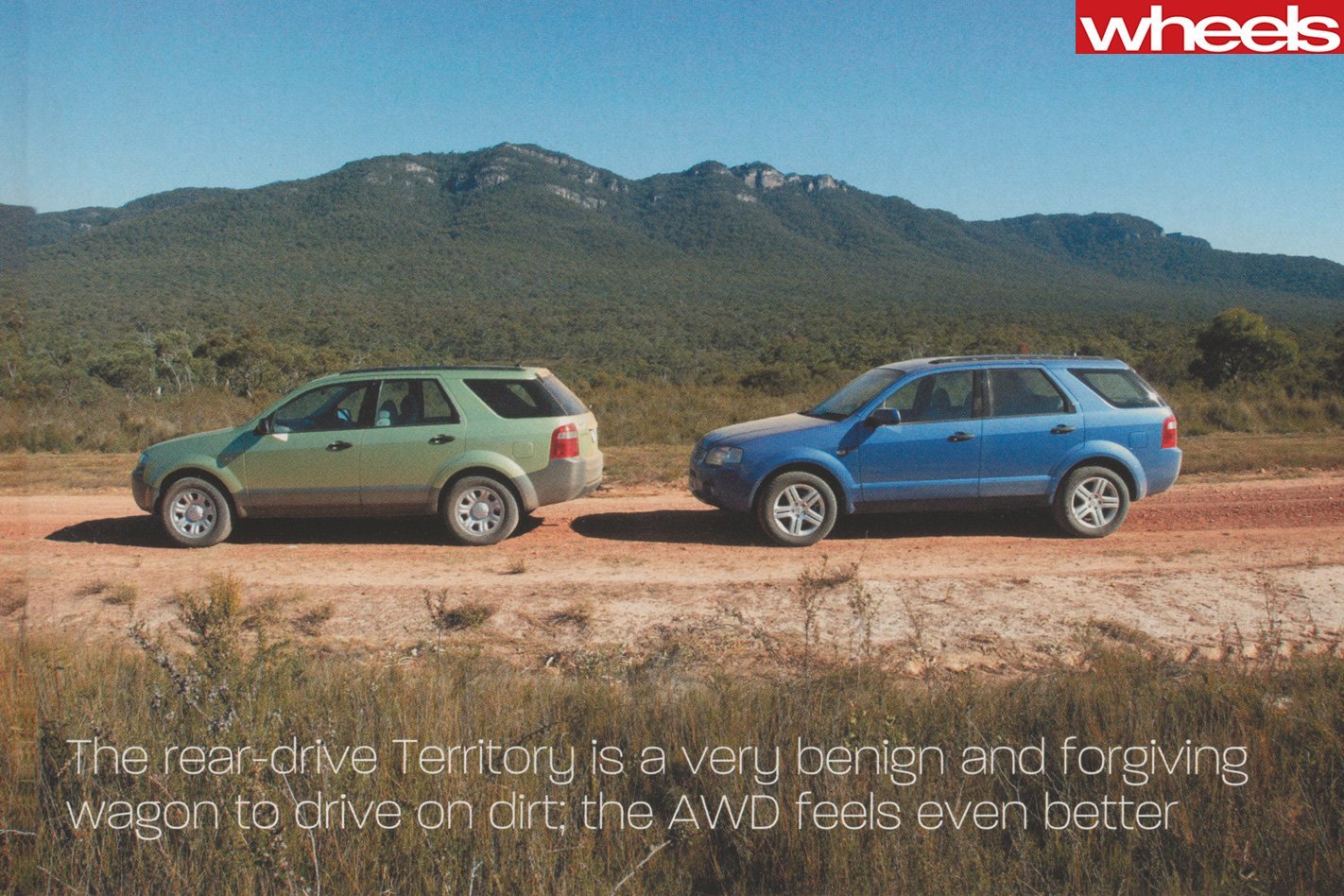
Deploying the optional third-row seat is quite easy. Move the kerb-side section of the second-row seat forward. Reach in and flip the third-row-seat backrest up, then tug the sliding seat cushion forward into position. The details are thoughtful. For instance, the third-row seat’s two headrests don’t have to be removed to fold the seat away again. Seatbelt guides are integrated in the backrest, meaning there’s no fiddly preparation required to ready the three-point belts for use.
It’s not a great seat for tall adults, but neither is it a kids-only affair. While there’s sufficient headroom for those up to 185cm tall, the seat’s cushion is low to the floor, dictating a knees-up position that’s certain to be hard on joints and bums on a long journey. Legroom is tight unless the second-row seat is shifted some way forward. Territory’s seating is well thought out, but just as much thought – perhaps more – was put into making the cabin useful and user-friendly. As well as all the expected storage spots, such as glovebox, lidded centre-console bin, and cupholders, there is a horde of additional options.

I’m seriously impressed with the Territory. Even in basic TX RWD form, the car has an interior that’s non-gimmicky and user-friendly. The exterior design is attractive, and its driving dynamics are simply brilliant. And, in Territory, Ford’s 4.0-litre six seems more civilised than ever before. The TX RWD is also great value.
Stealthily innovative, yet obviously excellent, the Territory is a great achievement by Ford Australia.

